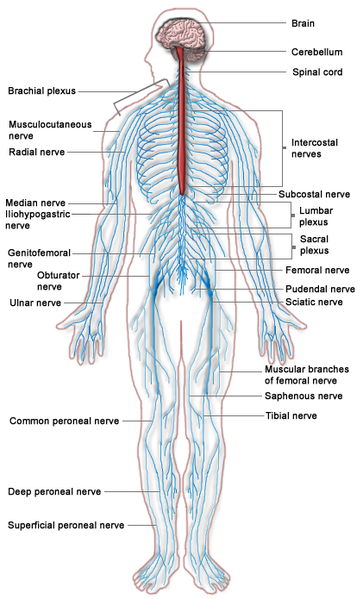The peripheral nervous system
(PNS, or occasionally PeNS) consists of the nerves and ganglia outside of the brain and spinal cord. The main function of the PNS is to connect thecentral nervous system (CNS) to the limbs and organs. Unlike the CNS, the PNS is not protected by the bone of spine and skull, or by the blood–brain barrier, leaving it exposed to toxins and mechanical injuries. The peripheral nervous system is divided into the somatic nervous system and the autonomic nervous system; some textbooks also include sensory systems. It is also a part of the nervous system.
The cranial nerves are part of the PNS with the exception of cranial nerve II, the optic nerve, along with the retina. The second cranial nerve is not a true peripheral nerve but a tract of the diencephalon.Cranial nerve ganglia originate in the CNS. However, the remaining eleven cranial nerve axons extend beyond the brain and are therefore considered part of the PNS.
Reflex tests
are simple physical tests of nervous system function.
Purpose
A reflex is a simple nerve circuit. A stimulus, such as a light tap with a rubber hammer, causes sensory neurons (nerve cells) to send signals to the spinal cord. There, the signals are conveyed both to the brainand to nerves that control muscles affected by the stimulus. Without any brain intervention, these muscles may respond to an appropriate stimulus by contracting.
Reflex tests measure the presence and strength of a number of reflexes. In so doing, they help to assess the integrity of the nerve circuits involved. Reflex tests are performed as part of a neurological exam, either a "mini-exam" done to quickly confirm integrity of the spinal cord, or a more complete exam performed to diagnose the presence and location of a spinal cord injury or neuromuscular disease.
Deep tendon reflexes are responses to muscle stretch. The familiar "knee-jerk" reflex is an example of a reflex. This tests the integrity of the spinal cord in the lower back region. The usual set of deep tendon reflexes tested, involving increasingly higher regions of the spinal cord, includes:
- ankle
- knee
- abdomen
- forearm
- biceps
- triceps
- patellar
Another type of reflex test is called the Babinski test, which involves gently stroking the sole of the foot to assess proper development and function of the spine and cerebral cortex.
Deep Tendon Reflexes
In a normal person, when a muscle tendon is tapped briskly, the muscle immediately contracts due to a two-neuron reflex arc involving the spinal or brainstem segment that innervates the muscle. The afferent neuron whose cell body lies in a dorsal root ganglion innervates the muscle or Golgi tendon organ associated with the muscles; the efferent neuron is an alpha motoneuron in the anterior horn of the cord. The cerebral cortex and a number of brainstem nuclei exert influence over the sensory input of the muscle spindles by means of the gamma motoneurons that are located in the anterior horn; these neurons supply a set of muscle fibers that control the length of the muscle spindle itself.
Hyporeflexia is an absent or diminished response to tapping. It usually indicates a disease that involves one or more of the components of the two-neuron reflex arc itself.
Hyperreflexia refers to hyperactive or repeating (clonic) reflexes. These usually indicate an interruption of corticospinal and other descending pathways that influence the reflex arc due to a suprasegmental lesion, that is, a lesion above the level of the spinal reflex pathways.
Infants
An infantis the very young offspring of a human or other mammal. When applied to humans, the term is usually considered synonymous with baby, but the latter is commonly applied to the young of any animal. When a human child learns to walk, the term toddler may be used instead.
The term infant is typically applied to young children between the ages of 1 month and 12 months; however, definitions may vary between birth and 3 years of age. A newborn is an infant who is only hours, days, or up to a few weeks old. In medical contexts, newborn or neonate (from Latin, neonatus, newborn) refers to an infant in the first 28 days after birth; the term applies topremature infants, postmature infants, and full term infants. Before birth, the term fetus is used.
Infant is also a legal term referring to any child under the age of legal adulthood.
Low back pain
Low back pain or lumbago is a common musculoskeletal disorder affecting 80% of people at some point in their lives. In the United States it is the most common cause of job-related disability, a leading contributor to missed work, and the second most common neurological ailment — only headache is more common.It can be either acute, subacute or chronic in duration. With conservative measures, the symptoms of low back pain typically show significant improvement within a few weeks from onset.





No hay comentarios:
Publicar un comentario